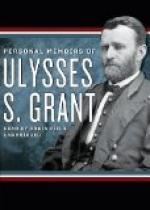This was the accomplishment of the first step contemplated in my instructions to Butler. He was to act from here, looking to Richmond as his objective point. I had given him to understand that I should aim to fight Lee between the Rapidan and Richmond if he would stand; but should Lee fall back into Richmond I would follow up and make a junction of the armies of the Potomac and the James on the James River. He was directed to secure a footing as far up the south side of the river as he could at as early a date as possible.
Butler was in position by the 6th of May and had begun intrenching, and on the 7th he sent out his cavalry from Suffolk to cut the Weldon Railroad. He also sent out detachments to destroy the railroad between Petersburg and Richmond, but no great success attended these latter efforts. He made no great effort to establish himself on that road and neglected to attack Petersburg, which was almost defenceless. About the 11th he advanced slowly until he reached the works at Drury’s Bluff, about half way between Bermuda Hundred and Richmond. In the mean time Beauregard had been gathering reinforcements. On the 16th he attacked Butler with great vigor, and with such success as to limit very materially the further usefulness of the Army of the James as a distinct factor in the campaign. I afterward ordered a portion of it to join the Army of the Potomac, leaving a sufficient force with Butler to man his works, hold securely the footing he had already gained and maintain a threatening front toward the rear of the Confederate capital.
The position which General Butler had chosen between the two rivers, the James and Appomattox, was one of great natural strength, one where a large area of ground might be thoroughly inclosed by means of a single intrenched line, and that a very short one in comparison with the extent of territory which it thoroughly protected. His right was protected by the James River, his left by the Appomattox, and his rear by their junction—the two streams uniting near by. The bends of the two streams shortened the line that had been chosen for intrenchments, while it increased the area which the line inclosed.
Previous to ordering any troops from Butler I sent my chief engineer, General Barnard, from the Army of the Potomac to that of the James to inspect Butler’s position and ascertain whether I could again safely make an order for General Butler’s movement in co-operation with mine, now that I was getting so near Richmond; or, if I could not, whether his position was strong enough to justify me in withdrawing some of his troops and having them brought round by water to White House to join me and reinforce the Army of the Potomac. General Barnard reported the position very strong for defensive purposes, and that I could do the latter with great security; but that General Butler could not move from where he was, in co-operation, to produce any effect. He said that the general




